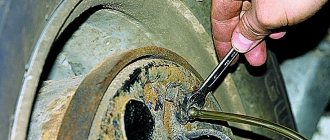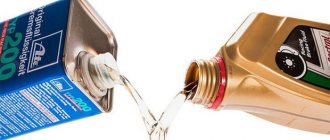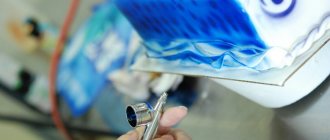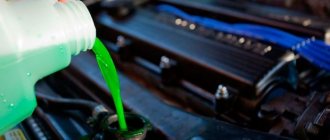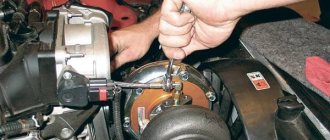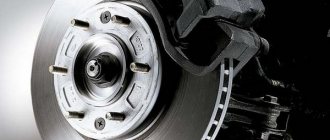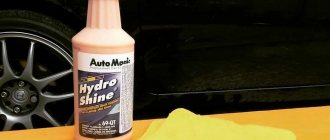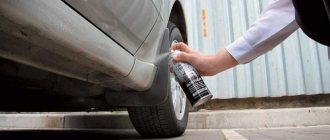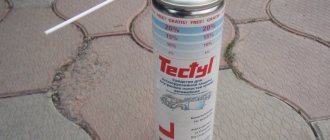The performance of the entire braking system depends on the quality of the brake fluid. Therefore, they are subject to quite stringent requirements. This includes not only the composition, but also the frequency of replacement.
Experienced car owners know how often they need to change the brake fluid in their car and how to do it correctly. However, beginners often neglect the replacement conditions, not even suspecting what consequences may arise due to such negligence. To dispel the myth that TJ has an unlimited shelf life, which means it doesn’t need to be changed at all, let’s look at the facts.
Why do you need to replace brake fluid?
So let's start with the basics. Brake fluid transfers pressure from the brake master cylinder (MBC) to the slave cylinder. The driver presses the brake, so the piston of the head brake cylinder creates pressure in the line. This force is transmitted through the channels to the calipers, as a result of which the pistons extend and the pads move apart. The pads create pressure on the working surface of the discs or drums (depending on the system). The resulting friction force leads to braking of the car.
What important characteristics should brake fluid have:
- incompressibility under pressure;
- resistance to low and high temperatures;
- good lubricating qualities;
- no impact on rubber, plastic and metal materials.
The most important point is incompressibility. In other words, the fuel fluid must fully ensure the transfer of excess pressure to the working cylinders or calipers.
Brake fluid also has one very unpleasant property - it is hygroscopic. That is, it absorbs moisture well from the surrounding space. The higher the water content in it, the lower its resistance to boiling and freezing. For example, the most common fuel fluid today, DOT-4, boils only after 230 °C, this is the minimum permissible value. There are liquids that do not boil until the temperature rises to 290 °C. If you increase the proportion of water in the liquid to 3.5%, then its boiling point will decrease to +155 °C, or by 30%.
When the braking system operates, a very large amount of thermal energy is generated. And this is understandable, because braking occurs through friction of the nodes. When braking, the contact patch on the elements sometimes heats up to 600 °C. Thermal energy is transferred through the parts to the liquid and heats it up. And if the temperature reaches the boiling point, the composition will boil. This will cause the formation of a gas plug, and the liquid will no longer be incompressible. This means that when you press the brake pedal, it will simply fail and the brakes will fail.
When is premature replacement necessary?
Let's consider when premature replacement is urgently needed:
- After purchasing a used car, you need to change all oils, other fluids and filters. Firstly, the previous owner may not have followed the replacement deadlines. Secondly, before the sale, no one invests in the car, that is, spare parts are not changed, etc. Thirdly, some people unknowingly change or add brake fluid only inside the reservoir itself. Stupid? Maybe, but they think the replacement is complete. When replacing (completely), you will protect yourself from all sorts of failures caused by low-quality (old, mixed with unknown what) brake fluid.
- The color of the brake fluid has changed from light yellow or pink (normal for such a substance) to cloudy gray, brown or dark red. This is due to the precipitation of certain substances, which means one thing, your liquid has become unusable. The additives that are present in it have changed their composition, as a result the quality of the liquid has decreased. We need to watch this. If you do not pay attention to this, then swelling and destruction of the rubber elements of the system occurs. There is gradual damage to the pistons that work inside the brake cylinder (these are scratches and scuffs on the mirror).
- The consistency of the TJ has changed. A change in properties is signaled by the consistency of the substance. This is not noticeable to the eye, but now there are devices for checking it, special testers. The device consists of a box with a probe, this probe is lowered into the tank. It heats up and determines the boiling point of the fuel fluid. Then the screen of the device will display the verdict “Normal” - replacement is not needed, “Replace urgently” - this means the composition already contains an unacceptable amount of water, it would be correct to replace it immediately in the car, and “It is advisable to replace” - then replacement is on the way, but not yet urgent degree of danger, you can go and buy replacement fluid.
This check takes no more than a minute, and the measurement accuracy is about 97%. The device can be purchased at any auto stores, and at prices affordable for everyone.
That's all the wisdom, friends. I hope you understand whether the brake fluid needs to be changed and how often. Remember, serviceable brakes are your safety and should not be neglected. If you haven't already, subscribe to the blog, send the link to your friends, they will benefit from this knowledge. See you on the pages of the site.
Types of brake fluids
Any auto chemicals, including TZ, are manufactured in compliance with international and domestic standards. Today there are two quality standards in production:
- FMVSS No. 116 is a document developed by the US Department of Transportation. The classification of liquid according to this standard ranges from DOT-1 to DOT-5.
- SAE J1703 and SAE J1704 are a document published by the Society of Automotive Engineers.
More often in the production of brake fluids, the American classification is used, the second is in much less demand. In addition to those listed, there are fuel oils based on mineral oils. They have completely different production standards, but are also used very rarely. Therefore, below we will talk about DOT classes, these include:
- DOT-1 and DOT-2 are now outdated and practically not used;
- DOT-3 and DOT-4 are the most popular TJs today, the basis of their composition is polyethylene glycol;
- DOT-5 - also a popular brake fluid, consists of silicones;
- DOT-5.1 - the same DOT-4, but with an improved composition, has better properties.
Important! Liquids of classes DOT-5 and DOT-5.1 have completely different compositions and differ in properties. They are not interchangeable.
Each of the listed TJs is divided into two categories:
- For cars without ABS.
- For cars with ABS.
Category information can be found in the name on the container. We also have additional classes of brake fluids, these include: DOT-4.5, DOT-4+, DOT-4*, etc. In fact, they are no different from the usual standard, and the addition is more of a clever marketing ploy.
Bleeding the brakes
To perform this procedure, you need to press the brake 5-6 times, after which the pedal is clamped. At this time (with the brake pressed), you need to unscrew the fitting on which the hose is located. As soon as your partner informs you that the pedal has gone to the floor, tighten the fitting.
It is recommended to repeat this operation until air stops escaping.
When replacing a brake fluid on their own, many car enthusiasts have a question: how to find out what kind of brake fluid is filled and whether it is possible to mix different compounds. In the first question, it is better not to guess and not try to determine the composition by taste, color or smell. It is better to change the fluid completely and attach a label from the bottle with the composition to the inside of the hood (or any other place).
As for the possibility of mixing, here, as in everything related to automotive fluids, it all depends on the basis of the composition.
Is it possible to mix brake fluids?
It is important to know not only how often to change technical specifications, but also which of them are compatible with each other and which are not. There are two general rules:
- DOT-3, DOT-4 and DOT-5.1 can be mixed.
- DOT-5 is strictly prohibited from being mixed with other compounds.
The first three types of DOT are based on glycol compounds and the same set of additives. Accordingly, their compositions are almost the same, which means mixing is permissible. However, it is not recommended.
Silicones are used in the manufacture of DOT-5. When it comes into contact with glycol, a reaction occurs and new substances are formed, that is, the liquid loses its properties.
avtoexperts.ru
One of the fluids important for the normal operation of a car is brake fluid. Read about why this fluid is needed, how often it requires replacement, and which brake fluids to use for optimal operation of the car’s braking system.
Brake fluid
The role of brake fluid in the “organism” of a car
The brake system, which is responsible for stopping the car in a timely manner and therefore plays an important role for the safety of car passengers, cannot work without brake fluid (BF). It is this that performs the main function of the brake system - it transmits the force from pressing the brake pedal through a hydraulic drive to the wheel braking mechanisms - pads and discs, as a result of which the car stops. Therefore, even in driving schools, novice car enthusiasts are strongly recommended to periodically check the levels of four service fluids: engine oil, antifreeze, glass cleaner and brake fluid, on which the optimal operation of the car depends.
Filling brake fluid
Composition and properties of brake fluids
The basis of the chemical composition of most brake fluids is polyglycol (up to 98%), less often manufacturers use silicone (up to 93%). The brake fluids used on Soviet cars had a mineral base (castor oil with alcohol in a 1:1 ratio). It is not recommended to use such fluids in modern cars due to their increased kinetic viscosity (they thicken at -20°) and low boiling point (at least 150°).
The remaining percentages in polyglycol and silicone TZ are represented by various additives that improve the characteristics of the brake fluid base and perform a number of useful functions, such as protecting the surfaces of the working mechanisms of the brake system or preventing oxidation of the TZ as a result of exposure to high temperatures.
It is not for nothing that we dwelled in detail on the chemical composition of brake fluids used in cars, since many car enthusiasts are interested in the question - “is it possible to mix TK with different chemical bases?” We answer : it is strictly not recommended to mix mineral fluids for the brake system with polyglycol and silicone fluids. From the interaction of the mineral and synthetic bases of these fluids, clots of castor oil can form, which clog the brake system lines, and this is fraught with malfunctions of the brake system. If you mix mineral and polyglycol TZ, then this “hellish mixture” will be absorbed into the surface of the rubber cuffs of the hydraulic brake parts, which will lead to their swelling and loss of sealing.
Although polyglycol TZ have a similar chemical composition and can be interchangeable, it is still not recommended to mix them in one brake system. The fact is that each technical specification manufacturer can change the composition of additives at its own discretion, and mixing them can lead to a deterioration in the main performance characteristics of the working fluid - viscosity, boiling point, hygroscopicity (ability to absorb water) or lubricating properties.
Silicone brake fluids must not be mixed with mineral and polyglycol fluids, since as a result the working environment becomes clogged with precipitated chemicals, which will lead to clogging of the brake system lines and failure of the brake cylinder components.
Classification of brake fluids
Today, most countries in the world have uniform standards for brake fluids, known as DOT (named after the agency that developed them - the Department of Transportation - the United States Department of Transportation) - such markings can often be found on packages of brake fluids. It means that the product is manufactured in accordance with the regulatory Federal Motor Vehicle Safety Standards FMVSS No. 116 and can be used in the braking systems of cars and trucks, depending on the technical characteristics of those vehicles. In addition to the American standard, brake fluids are labeled in accordance with standards adopted in a number of European and Asian countries (ISO 4925, SAE J 1703 and others).
Brake fluid classification
But they all classify brake fluids according to two parameters - their kinematic viscosity and boiling point. The first is responsible for the ability of the working fluid to circulate in the brake system line (hydraulic drive, pipes) at extreme operating temperatures: from -40 to +100 degrees Celsius. The second is for preventing the formation of a vapor lock, which forms at high temperatures and can lead to the brake pedal not working at the right time. When classifying TZ by boiling point, two of its states are distinguished - the boiling point of a liquid without water impurities (“dry” TZ) and the boiling point of a liquid containing up to 3.5% water (“wet” TZ). The “dry” boiling point of the brake fluid is determined by the new, freshly filled working fluid, which has not had time to “acquire” water and therefore has high performance characteristics. The “moistened” boiling point of TK refers to the working fluid, which has been in use for 2-3 years and contains a certain amount of moisture. Read more about this in the section “Service Life of Brake Fluids”. Depending on these parameters, all brake fluids are divided into four classes.
DOT 3. The “dry” boiling point of this brake fluid is at least 205°, and the “wet” boiling point is at least 140°. The kinematic viscosity of such a TZ at +100° is no more than 1.5 mm²/s, and at -40 – no less than 1500 mm²/s. The color of this brake fluid is light yellow. Application: intended for use in cars whose maximum speed is no more than 160 km/h, the braking system of which uses disc (on the front axle) and drum (on the rear axle) brakes.
DOT-3
DOT 4. The “dry” boiling point of this brake fluid is at least 230°, and the “wet” boiling point is at least 155°. The kinematic viscosity of such a TZ at +100° is no more than 1.5 mm²/s, and at -40 – no less than 1800 mm²/s. The color of this brake fluid is yellow. Application: intended for use in vehicles whose maximum speed is up to 220 km/h. The braking system of such cars has disc (ventilated) brakes.
DOT-4 brake fluid
DOT 5. The “dry” boiling point of this brake fluid is at least 260°, and the “wet” boiling point is at least 180°. The kinematic viscosity of such a TZ at +100° is no more than 1.5 mm²/s, and at -40 – no less than 900 mm²/s. The color of this brake fluid is dark red. In contrast to the above-mentioned TK, DOT 5 is based on silicone, not polyglycol. Application: intended for use on special vehicles operating in conditions of extreme temperatures for brake systems, and therefore not used on ordinary passenger cars.
DOT 5.1. The “dry” boiling point of this brake fluid is at least 270°, and the “wet” boiling point is at least 190°. The kinematic viscosity of such a TZ at +100° is no more than 1.5 mm²/s, and at -40 – no less than 900 mm²/s. The color of this brake fluid is light brown. Application: intended for use in brake systems of sports racing cars, in which the temperatures of the working fluids reach critical values.
DOT 5.1
Pros and cons of brake fluids
All of the above brake fluids have their advantages and disadvantages. For convenience, we indicate them in the table below:
| TK class | Advantages | Flaws |
| DOT 3 |
|
|
| DOT 4 |
|
|
| DOT 5 |
|
|
| DOT 5.1 |
|
|
When to change brake fluid?
The service life of brake fluid directly depends on its chemical composition.
Mineral TZ, due to its chemical characteristics (low hygroscopicity, good lubricating properties), has a fairly long service life (up to 10 years). But when water gets into the liquid, for example, in the event of depressurization of the brake system, its properties change (the boiling point drops, the viscosity increases), and it can no longer perform its functions, which can lead to brake failure. It is recommended to periodically inspect (once a year) the brake system and the condition of the fluid, which can be determined in the laboratory.
Polyglycol TZ has a medium or high degree of hygroscopicity, and therefore its condition should be checked twice a year. You can assess the condition of polyglycol TZ visually: if the liquid has darkened or there is noticeable sediment in it, then it needs to be completely replaced. In a year, such TZ is capable of absorbing up to 3% moisture. If this figure exceeds 8%, then the boiling point of the brake fluid may drop to 100°, which will lead to boiling of the brake fluid and failure of the entire brake system. Car manufacturers recommend changing polyglycol-based brake fluid every 40 thousand kilometers or every 2-3 years. Typically, such brake fluid is completely changed during the installation of new external brake mechanisms (pads and discs).
Silicone TZ is characterized by long service life, since its chemical composition is more resistant to external influences (moisture). As a rule, silicone brake fluids are replaced after 10-15 years from the moment they were poured into the brake system.
How often should you change brake fluid?
The frequency of TJ replacement is influenced by several factors:
- type of braking system;
- under what conditions the transport was operated;
- TJ class and its additives.
For most cars, the brake fluid replacement period is 40,000 km, provided that the temperature in the system does not rise above 150 °C. For premium cars and sports cars, this period is even shorter - 20,000 km. More accurate information can be found in the technical documentation for using the vehicle.
Car service technicians do not recommend simply adding fresh brake fluid. Needs a complete replacement. Even if most of it is updated, the properties will be different from the new one. The same can be said about mixing.
The need to replace the TJ can be indicated by its color. For example, the normal color of glycol compounds is light yellow or light brown, while that of silicone compounds is dark red. In case of cloudiness or a significant change in shades, the TZ should be changed or contact a car service or service station. Delay has consequences.
What is the need?
But why change the brake fluid at all, which, in essence, makes it a consumable item? Maybe just pour it into the system once and forget it?! This cannot be done under any circumstances for objective reasons! The working fluid circulates along the circuit, having its own special qualities:
- Hygroscopicity – the ability to absorb moisture vapor from the air.
- High temperature resistance.
Initially, the liquid has almost zero humidity, due to which its boiling threshold is quite significant. It is capable of operating in the system under a wide range of temperatures - from 200 °C to 260 °C, without boiling.
How to choose good brake fluid
When choosing a TJ, it is very important to rely on the classification, which is determined by DOT standards. The categories take into account the following indicators:
- Boiling point is the temperature at which active evaporation of a substance occurs and the formation of a gas plug, which reduces braking efficiency. There are two boiling points: “dry” - without water content, “moistened” - up to 3.5% water.
- The possibility of combining with a sealant depends on the acid-base balance of the fluid. At levels below 7, the substance will have an aggressive effect on steel elements. If more than 12 – for non-ferrous metals. A good liquid will have a pH between 7 and 11.5.
- Resistance to freezing - this parameter determines whether it can be used in conditions of low temperatures. This property is indicated by the viscosity parameter; it is measured at a temperature of -40 °C. The operation of ABS, TSC and ESP depends on it.
- Anti-corrosion protection - you won’t be able to find out this parameter when purchasing. Special inhibitors are added to brake fluids to suppress its oxidative processes throughout its entire service life.
When choosing a new brake fluid, give preference to proven brands. Little-known, untested manufacturers may add an insufficient amount of additives and inhibitors during manufacturing, and the stable operation of the system under various conditions depends on this - temperature conditions, the presence of foreign impurities, etc.
TOP 6 most popular brake fluids
The rating contains the most popular liquids with excellent characteristics that are available today on the domestic auto chemical market. The review was compiled based on the opinions of car service and service station specialists, as well as reviews from motorists in the country.
Eurol Brakefluid DOT 5 silicone (1 l)
The main difference between the liquid is the large number of vehicle approvals and longer service life. Operating temperature range from -40 °C to +260 °C, with use it decreases to -30 – +180 °C. In the first two years, silicone, which is the basis of the composition, completely prevents the accumulation of moisture in the liquid fluid, but during the process of thermal decomposition of some materials, water has the opportunity to be absorbed.
The liquid of this brand is recommended for use not only in cars, but also in sports motorcycles and even choppers. The service life of the composition is up to 5 years.
Advantages:
- long service life;
- high technical characteristics;
- versatility.
Among the disadvantages, it is worth noting the extremely high cost.
TRW/Lucas PFB125 DOT 5 (0.25 l)
Silicone brake fluid is distributed in small containers. You can rarely find them on the shelves of auto stores, but ordering them online is not difficult. The boiling point of the “dry” composition is + 280 ° C, the best temperature in the class.
However, the second place in the ranking is due to the inability to maintain stability of properties during the process of resource development. The indicators drop after six months of active use and do not recover. Often, by the end of the service life, the boiling point is below 160 °C. Perhaps the reason for this is the high prevalence of counterfeit products. It is not so easy to distinguish a fake; the manufacturer did not take care of the protective elements on the container.
Advantages:
- good performance indicators;
- Suitable for all passenger cars.
Among the disadvantages, as already mentioned, is the lack of stability of characteristics during operation.
TOYOTA DOT 4 1 l
The TJ is designed for intensive use of the braking system and high loads. Can be used on all types of transport: cars, SUVs, trucks, etc. Suitable for both drum and disc brakes.
It can be mixed with DOT-4 brands produced on a glycol basis. Boiling point +252 °C. There is a good set of additives, including anti-corrosion ones, which provides good protection for metal parts.
Advantages:
- Can be used on all types of transport;
- does not lose characteristics throughout the entire service life;
- has good anti-corrosion properties.
Among the disadvantages, the high cost of the liquid is noted.
Nissan DOT 4 1 l
Japanese automakers have developed brake fluid for their line of vehicles. It is suitable for use in both passenger cars and minibuses. A transparent liquid with a yellowish tint will allow the car owner to easily determine by its turbidity the need to replace it with a new one in case of saturation with water. True, if the tank is also yellow, it will be difficult to make out the level.
The composition has a density of 0.868 and freezes at a temperature of -45 °C. Thanks to this property, the TJ is perfect for use in any region of the country - in winter, while the engine is warming up, the main cylinder and reservoir are already warm. Just a couple of pedal presses are enough and the braking system is ready for use.
Advantages:
- good anti-corrosion properties to protect cast iron and steel elements;
- fairly long shelf life (3 years);
- low freezing temperature threshold.
Disadvantages include high transparency, which makes it sometimes difficult to determine the level in the system.
Castrol React Performance DOT 4
The basis of this composition is polyalkylene glycol ethers with the addition of boron. Due to this, the liquid received a higher boiling point, even after absorption of moisture during operation, the boiling point of the “moistened” TF is +180 °C. This is the best indicator among glycol liquids. Operational life is about 2 years.
The remaining characteristics do not differ much from those from the DOT-4 class; the fresh viscosity is 1,200 mm2/s, as established by the standards. Acid-base balance at 7.2 pH.
Advantages:
- optimal viscosity when operating at low temperatures;
- the presence of boron in the composition increases the boiling point;
- chemical neutrality to metals.
The downside of this brake fluid is its high price.
Castrol Brake Fluid DOT 4 1 l
The composition of glycol liquid includes polyalkylene glycol ethers and boron. Thanks to this, it can be used on trucks and cars, as well as in motorcycles. Suitable for disc and drum systems. The kinematic viscosity even at -40 °C is 1,200 mm2/s, which ensures their reliable operation even in severe frosts. The boiling point of the “dry” composition is +260 °C, the “moistened” one is +165 °C. The shelf life in the container is up to 4 years.
Advantages:
- high technical characteristics of the composition;
- the boiling point of even a “moistened” liquid is +165 C;
- long shelf life;
- Suitable for all types of equipment.
Among the disadvantages, car owners note that sometimes, after pouring into the system, it quickly absorbs moisture and begins to lose its properties.
Replacement instructions
To change the fluid in the brake system of the vast majority of cars, it is enough to have simple tools and devices:
- jack and wrench for wheel bolts (nuts);
- an 8–10 mm socket wrench for unscrewing the drain fittings on the working cylinders;
- a transparent tube of the same size and a plastic bottle;
- medical syringe with a volume of 20 cm3.
Working conditions: a garage or a flat area on the street. When the time has come according to the replacement regulations, buy a new composition of a suitable brand, attract an assistant and begin work in the following order:
- Install and secure the car on the site using anti-roll bars. Loosen the right rear wheel bolts and remove it by jacking up the car.
- Lift the hood lid and unscrew the expansion tank cap. Using a syringe, draw out the maximum amount of liquid from the tank.
- Add the new mixture to the required level, ask an assistant to take the driver’s seat.
- Grab the wheel cylinder fitting with a wrench, put on the tube and lower the other end into an open bottle.
- Have an assistant press the brake pedal 5–7 times and hold it pressed. Unscrew the pipe with a wrench and watch the old fuel fluid flow into the container. When the flow decreases, tighten the fitting.
- Repeat the action several times, observing the level in the expansion tank and adding liquid as necessary. When clean fluid flows through the tube without bubbles, tighten the pipe and move on to the next wheel.
You should not empty the system and change it through a tube with opaque walls - this will prevent you from noticing air bubbles and the flow of new liquid. At the end of the work, be sure to check the brakes while driving - after sharply pressing the pedal, all wheels in the car should brake at the same time. If there is air left in any circuit, the car will deviate from the straight path when braking.
